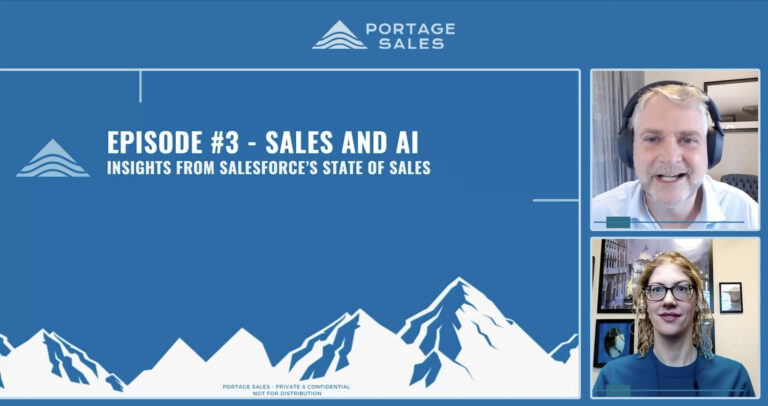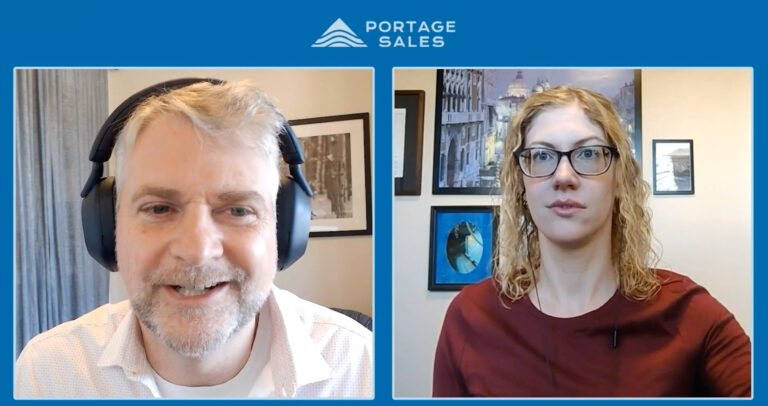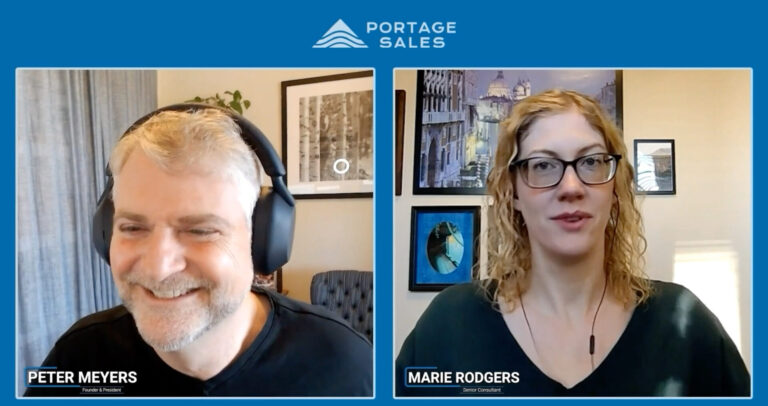
Gaining Sales Productivity From AI
AI in Sales: Too Little Strategy, Training, and Trust
January 8th, 2024
The discovery call is where the magic starts.
We begin to turn possibilities into realities.
Discovery is the foundation of effective selling and can be the difference between a sale won or lost. That’s why nailing the discovery call is crucial. It’s a delicate art that balances strategic selling with genuine connections. I’m here to guide you through five pivotal steps that can dramatically transform your discovery call dialogues.
Drawing from our rich experiences and industry-leading insights at Portage, I’ll show you how to elevate your discovery calls from mere formalities to powerful, rapport-building conversations. These steps aren’t just methods; they’re the key to unlocking deeper, more productive, and successful interactions. Together, we’ll ensure that every discovery call you make opens new opportunities and cements your confidence and success.
While you often come away from a discovery call with a gut feeling as to how it went, focusing on these leading indicators of discovery call success will help make the process less abstract and more measurable.
1.
Were they actively participating, asking questions, and showing interest?
High engagement typically indicates a successful discovery call.
2.
Was there a good balance, or did one party dominate the conversation?
Successful discovery calls usually involve active participation from both sides.
3.
Did you uncover deep insights about the client’s needs, challenges, and goals?
The depth and relevance of the information uncovered indicate effective questioning and listening.
4.
Was the conversation smooth and natural, or was it forced and one-sided?
A good flow suggests comfort and rapport, important for successful relationships.
5.
Did the client clearly understand how your offerings can benefit them?
Their grasp and interest in your solutions are vital.
6.
Was the tone positive, and was there enthusiasm from both sides?
‘How they say it’ is often more telling of buyer engagement and buy-in than ‘what they say.’
7.
Did you adjust your solution and value pitch based on the client’s responses and needs?
Adaptability is key in addressing the specific needs of the client.
8.
Did the client express trust or acknowledgment of your expertise?
Building trust is a cornerstone of successful sales relationships.
9.
Did you and your client agree upon a clear plan for moving forward?
This indicates a mutual interest in continuing the conversation.
Let’s start unpacking the five steps to discovery call success.
Let’s kick off our journey to discovery call mastery with the first and foundational step – preparing a discovery call plan. You might think, “Peter, I’ve done dozens of these discovery calls; do I need a plan?” Absolutely, and here’s why. A well-prepared plan for a discovery call is like a roadmap for your call; it keeps you focused, ensures you cover all critical areas, and, most importantly, shows your prospective client that you value and respect their time during the discovery call.
Picture this: You walk into a discovery call, and instead of the usual winging it, you’ve got a plan. It’s like having a roadmap in an unfamiliar city. This isn’t about filling in a template; it’s about showing your client that you’ve done your homework and that their business matters to you. Look them up on their website and LinkedIn, maybe even Crunchbase. Finding something common, like a shared interest or background, is key to building early trust. This is your chance to make a real connection.
Here’s what happens when you’re prepared: you gain trust. Imagine the difference between a salesperson who stumbles through a discovery call and one who knows their stuff. Who would you trust more? Exactly. A prepared salesperson comes off as credible, reliable, and genuinely interested in finding the right solution for the client.
Now, when you’ve got that plan in your back pocket, the game changes. You’re not just selling; you’re consulting. You understand their challenges, have insights, and are ready to tailor your pitch to their needs. Top sales reps spend about half the time listening. Steer clear of yes-or-no questions and encourage your client to share more. When they mention a challenge, acknowledge it to demonstrate your understanding. And if you find yourself talking too much, it’s a sign to take a breath and let your client share their thoughts.
A discovery call plan isn’t just a formality; it’s your secret weapon. It’s about showing up as more than a salesperson. You’re a problem-solver, an ally in their industry. With a solid plan, you can navigate the discovery call with confidence, ask the right questions, and connect with your client. Trust me, it makes all the difference.
Building Rapport in your discovery calls is foundational. This is where you make your mark, transforming a simple discovery call into a bridge for lasting relationships. Remember, folks, it’s about connecting on a human level in every discovery call because, at the end of the day, people need to buy you before they buy into your solution.
Imagine you’re on a discovery call, trying to connect, but it’s like talking to a screen. In today’s virtual world, establishing rapport is tougher but more crucial than ever. Miss this step; you’re just another voice in the digital void.
Now, let’s face it: failing to build rapport isn’t just a missed opportunity; it’s a potential deal-breaker. Without that connection, you’re not building trust, and without trust, you’re not building much of anything. It’s the difference between a memorable conversation and one forgotten as soon as it ends.
Breakthrough Moments – – Sam’s Turning Point
Let me tell you about Sam. He is a brilliant salesperson, but his discovery calls? All facts, features, and talk times above 70-80%. I see it all the time in our Portage call coaching sessions. It wasn’t until he started weaving personal conversations and actively listening to his clients that his sales went from flatline to skyrocket. For Sam, it was about making each discovery call a two-way street, not a one-way broadcast.
Sam isn’t alone in this journey of transformation. Once you start focusing on building genuine connections, you shift from just pushing your product and you start understanding people and their challenges. That’s the power of rapport.
Here’s the game plan: Start with something personal. Leverage your discovery call plan insights by asking about their day, their city, and their professional journey. This isn’t idle chit-chat; it’s the cornerstone of a real relationship. Then, listen – not just their words but their story. Use mirroring techniques to create a subconscious bond – keep it natural, no mimicking. Share stories that resonate with their experience and show that you get them. Empathy is your friend here; it’s about showing you’re there to find a solution.
Try out some of these tips, and most importantly, be your authentic self.
I challenge you, on your next discovery call, to put these tips into action. Start with empathy, add a dash of storytelling, mix in some active listening, and voila! You’re building rapport, and laying the groundwork for a relationship beyond business. It’s about communicating that they’re not just buying a product but starting a partnership.
Let’s discuss the core of any great discovery call – leveling up with the right questions. The goal here is to uncover as much valuable information as possible, in a way that feels natural and engaging for your client.
Start with open-ended questions. These are your golden tickets to valuable insights. Questions like, “What challenges are you currently facing?” or “What does success look like for your team?” encourage detailed responses and open the conversation for deeper exploration.
But how do you elevate a good conversation to a great one? Enter the trifecta of knowledge (k), insight (i), and experience (e):
Knowledge: What’s their situation?
Insight: What are their problems, and what implications do they face?
Experience: How do my own experiences provide added perspective?
Using this formula you’ll lead with questions sharpened by prior research and understanding like, “Given your company’s recent foray into renewable energy, what challenges are you grappling with?” or “Considering your impressive customer retention rates, how do you plan to leverage this strength for future growth?” Such tailored questions show you’re connecting dots from your research to their situation, building credibility and steering the conversation toward deeper insights and engagement.
After grabbing their attention with targeted questions, stoke the fires of interest with further exploration. Dig deeper with follow-up questions. If a client mentions a challenge, ask them to elaborate. What has caused this challenge? How has it impacted their business? This shows you’re listening and genuinely interested in understanding their situation. This demonstrates your keen listening skills and commitment to engaging them in a conversation that delves beneath the surface. More importantly, their answers can help accelerate the deal to the next step.
For a more in-depth dive into formulating these questions and how they can elevate your call, stay tuned for our upcoming Discovery Call Questions blog. There, you’ll also discover a Next-Level Question Generator that helps you put your customer knowledge, insights, and experience into action.
In Step 4 below, you’ll use the prospect needs and challenges you’ve uncovered to kindle a desire for your solutions. By overtly connecting their needs to the benefits of your solutions, you’ll illustrate how your services can solve their important problems and propel their business (and career!) to success.
Think about those times you’re in a discovery call, and it feels like you’re shooting in the dark. You’re pitching solutions that, while great on paper, just don’t seem to click with your client. It’s a frustrating dance of guesswork and mismatches.
Now, imagine a scenario where you’ve mastered the discovery call. You’ve applied our techniques brilliantly. The result? You deeply understand your client’s specific needs. The game changes. You’re no longer pitching a one-size-fits-all solution. Instead, you’re presenting a bespoke solution, finely tuned to address their unique challenges and aspirations. The engagement is palpable; your client is actively involved because your solution is a mirror reflecting their specific situation.
How do you bridge the gap between understanding and solution? It’s all in how you use the gold that you’ve mined from your discovery calls:
This part of the discovery call is a tapestry of conversation, understanding, and co-creation. It’s where you clarify, solve, and qualify – all in real-time. By focusing on these crucial themes, you’re forging a relationship built on understanding, trust, and mutual commitment to finding the right solution.
We’ve arrived at the final, yet pivotal, step of the discovery call – establishing clear next steps. This stage is all about clarity and commitment. It’s where you ensure that the momentum built during the discovery call translates into actionable steps, moving the relationship forward in a positive and structured manner.
Too often, I cringe at the end of listening to recorded sales discovery calls because the salesperson has short-changed themselves. Allow at least 5-10 minutes at the end of the discovery call to fully address what was covered and to align on what will happen next. When you leave too little time for the next steps, you add significant risk to the deal’s momentum. Too little time for the next steps can kill deals.
Based on the conversation, propose a follow-up plan. This could be a more detailed discussion, a demonstration of your product, or a meeting with other key decision-makers in their organization. Ensure this plan is tailored to the client’s interest in or concern during the discovery call.
Before ending the discovery call, confirm that the client is on the same page regarding the next steps. Ask if they have any other questions or need further clarification on any points discussed. This is also a great time to reiterate your excitement about possibly working together.
Finally, end the discovery call on a positive and upbeat note. Express your appreciation for their time and the opportunity to discuss their needs. A friendly, optimistic close sets a positive tone for future interactions.
Establishing clear next steps is essential to keeping the sales process moving. It turns a good conversation into a pathway for action, ensuring that you and the client know exactly what comes next and are excited about the possibilities ahead.
And that’s a wrap! – our five critical steps to turn your discovery calls into potent conversations that balance strategic selling with a genuine connection. From crafting a thoughtful discovery call plan to setting clear next steps, each phase is a vital part of a larger strategy that, when combined, crafts an impactful discovery call approach.
This isn’t just a list we threw together overnight. It’s the result of years of experience, countless calls, and a whole lot of trial and error. We’ve refined this discovery call checklist to ensure it covers all the bases in this guide, making your discovery calls as effective and impactful as possible.
After each discovery call you complete, take a few minutes to use the checklist to review and score your success. Pay careful attention to the one area you hit out of the park, and the one area that could use some improvement. Avoid taking on too much at once. This way you will make far more progress.
The essence of a successful discovery call lies in your ability to listen, understand, and connect. It’s about demonstrating to your clients that you’re more than a salesperson; you’re a trusted advisor deeply invested in their success. By embracing these steps, you’re not just gearing up for productive discovery calls; you’re laying the foundation for long-standing, mutually rewarding relationships.
At Portage Sales, we’ve witnessed the remarkable impact of these steps – higher engagement, stronger client relationships, and more closed deals. The beauty of this approach? It not only refines your sales process but also enriches both your experience and your clients.
So, embrace these steps, make them your own, and watch as your discovery calls transform into one of your strongest moments with prospects and customers. My team at Portage is here to guide you on this journey. Let’s turn your discovery calls into not just successful interactions, but memorable experiences that build lasting connections.

Peter is an executive advisor, consultant, and facilitator who happily lives and breathes sales strategy and customer experience. With a razor-sharp focus on making sales teams more effective, he combines his creativity, collaborative style, and relentless drive for results. Before Portage, he held VP roles in sales, marketing, and product innovation at LoyaltyOne, Epsilon, The Toronto Region Board of Trade, and Engage People. When he’s not exploring new sales strategies, he’s taking in the great outdoors.

AI in Sales: Too Little Strategy, Training, and Trust


Insights from SalesForce’s State of Sales report – key challenges faced by Sales teams.
Ready to take action? Book a discovery session now to get new clarity on your opportunities.
Copyright © 2025 Portage Sales. All Rights Reserved.
Did you Download our Discovery Call Checklist?
Download our Discovery Call Checklist